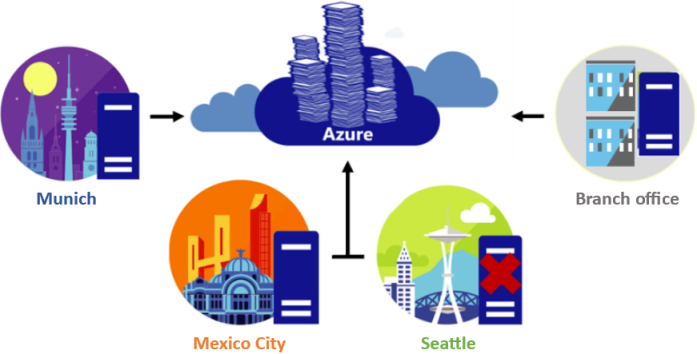Consider Azure File Sync
Azure File Sync enables you to cache several Azure Files shares on an on-premises Windows Server or cloud virtual machine. You can use Azure File Sync to centralize your organization's file shares in Azure Files, while keeping the flexibility, performance, and compatibility of an on-premises file server.

Things to know about Azure File Sync
Let's take a look at the characteristics of Azure File Sync.
Azure File Sync transforms Windows Server into a quick cache of your Azure Files shares.
You can use any protocol that's available on Windows Server to access your data locally with Azure File Sync, including SMB, NFS, and FTPS.
Azure File Sync supports as many caches as you need around the world.
Cloud tiering
Cloud tiering is an optional feature of Azure File Sync. Frequently accessed files are cached locally on the server while all other files are tiered to Azure Files based on policy settings.
When a file is tiered, Azure File Sync replaces the file locally with a pointer. A pointer is commonly referred to as a reparse point. The parse point represents a URL to the file in Azure Files.
When a user opens a tiered file, Azure File Sync seamlessly recalls the file data from Azure Files without the user needing to know that the file is stored in Azure.
Cloud tiering files have greyed icons with an offline
Ofile attribute to let the user know when the file is only in Azure.
Tip
Use the Ask Learn icon (top right) to learn more about File Sync and cloud tiering.
Things to consider when using Azure File Sync
There are many advantages to using Azure File Sync. Consider the following scenarios, and think about how you can use Azure File Sync with your Azure Files shares.
Consider application lift and shift. Use Azure File Sync to move applications that require access between Azure and on-premises systems. Provide write access to the same data across Windows Servers and Azure Files.
Consider support for branch offices. Support your branch offices that need to back up files by using Azure File Sync. Use the service to set up a new server that connects to Azure storage.
Consider backup and disaster recovery. After you implement Azure File Sync, Azure Backup backs up your on-premises data. Restore file metadata immediately and recall data as needed for rapid disaster recovery.
Consider file archiving with cloud tiering. Azure File Sync stores only recently accessed data on local servers. Implement cloud tiering so older data moves to Azure Files.